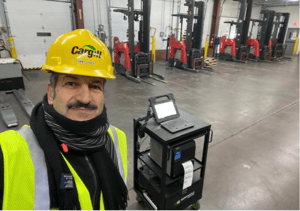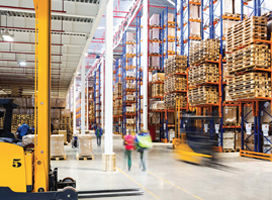
As the average age of employees in the workforce increases, so does the need for more automation options to adapt to the needs of those employees. Data from various studies and real-life experience reveals compelling insights about how robots are becoming integral in addressing labor shortages and reshaping industries.
Major Workforce and Market Challenges Facing Businesses
According to the latest report from the U.S. Chamber of Commerce, the workforce is shrinking due to simple demographics. Specifically, the Baby Boomer generation, which was three times larger than its predecessor, is growing older and creating a shortfall in the workforce.
As Boomers and Gen X get older, there aren’t as many people available to replace those jobs. However, many in this demographic either can’t or don’t want to exit the workforce. According to a report by Mercer, there is now an alarming $70 trillion retirement savings gap globally, which is expected to increase to $400 trillion by 2050. Even when people have the financial means to retire, older workers often prefer to remain active professionally.
Retaining older workers creates both opportunities and challenges for businesses. For example, researchers have found that older workers tend to outperform their younger counterparts in speech and language skills. Older workers also provide critical continuity and knowledge consolidation during challenging times. An age-diverse workforce can also reduce turnover, lower costs, and increase organizational commitment.
Apart from the benefits of holding onto older workers, what about the challenges? As workers age, they may face some physical and other limitations, making some positions more difficult. Fortunately, a growing number of organizations are implementing automation solutions to address these issues.
How Technology is Changing the Nature of Work
At the same time, the average age in the global workforce is getting older, and technological developments are happening at a record pace. There are more digital workers than ever, computers have astounding computational power, and there has been rapid development in artificial intelligence (AI) and robotics.
According to Mercer, manual and routine work tasks have been on the decline since the 1970s. The concept of “work” has shifted as various functions within manufacturing, warehousing, offices, and even the executive suite are structured more around tasks as opposed to jobs. This won’t necessarily eliminate roles for aging workers but rather change them to make these jobs easier and more accessible.
Leveraging Automation to Help Your Aging Workforce Succeed
 Entirely separate from the issue of having an aging workforce, many businesses are choosing to implement automation solutions to take over thousands of distinct work activities. This benefits workers of all ages, including those in post-retirement who want or need to continue working.
Entirely separate from the issue of having an aging workforce, many businesses are choosing to implement automation solutions to take over thousands of distinct work activities. This benefits workers of all ages, including those in post-retirement who want or need to continue working.
A byproduct of leveraging automation is that it creates “senior-friendly workplaces” where current employees feel comfortable remaining in their positions as they age, and retirement-age workers can move into a new position without the fear that they won’t be able to fulfill the requirements.
According to a recent study by the Urban Institute, many investments in technology can make older workers’ jobs less physically strenuous because automation takes over physical tasks but still requires human operators for guidance. Many of the solutions being introduced are assisting people who are facing declining physical capacity. These solutions also make work safer, more productive, and more enjoyable for all employees, not just the older ones.
Some examples of automation solutions that are helping aging workers succeed include:
Robotics
Robots in the workplace aren’t necessarily meant to replace workers. Instead, they can take over repetitive, dangerous, and physically demanding tasks that might be challenging for older workers. These solutions will need skilled workers to guide and maintain them, which are ideal solutions for this workforce segment.
Mobile-Powered Carts
 In some positions, such as those in retail and warehouse settings, workers are required to walk miles each day to collect instructions or input data into centralized computers. Mobile-powered carts can take the technology to the worker and reduce the physical strain inherent in these positions.
In some positions, such as those in retail and warehouse settings, workers are required to walk miles each day to collect instructions or input data into centralized computers. Mobile-powered carts can take the technology to the worker and reduce the physical strain inherent in these positions.
Wearables
Instead of requiring workers to bend, reach, and pull continuously, many employers are implementing wearable technology to streamline various processes. These Bluetooth-enabled wireless devices can deliver visual or audio instructions to workers to make tasks easier and less labor-intensive.
Older Workers May Need to Learn New Skills
Any workers, not just older employees, who are in a situation where automation solutions have been implemented will need to learn to use them safely and effectively. This can lead to discomfort for some, but these technology tools were made to be as user-friendly as possible.
The good news is that today’s workers over the age of 50 have already been down this road before. These are the people who had to live through the invention of the internet. Learning to use a few automation solutions should be a walk in the park.
Businesses Will Need Older Workers Going Forward
According to a report by Bain & Company, roughly 150 million workers will be age 55 by 2030 as demographics shift. In the coming years, this group will account for over a quarter of the U.S. workforce, which is an increase from 15% just a decade ago.
The Organization for Economic Cooperation and Development determined that businesses that retain older workers tend to have higher productivity rates. While not all older Americans want to continue working, these technology solutions are giving them a choice, and businesses can benefit from their knowledge and soft skills.
While the retention of older workers benefits everyone, businesses need to find ways to make workplaces more user-friendly for aging populations. Fortunately, the same automation solutions that are driving gains in other parts of the business are also helping organizations retain valuable employees, create safer workplaces, and produce better overall results.

